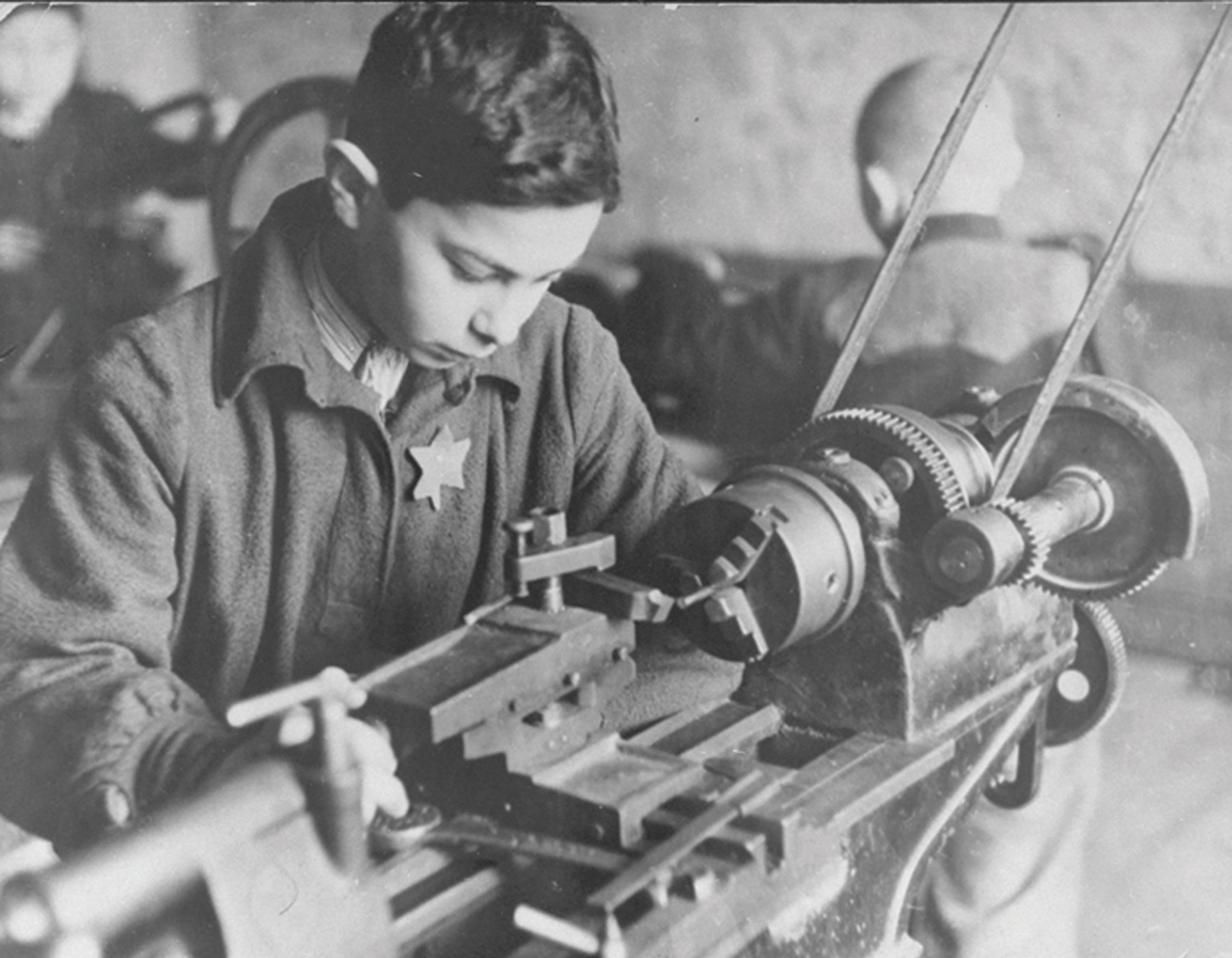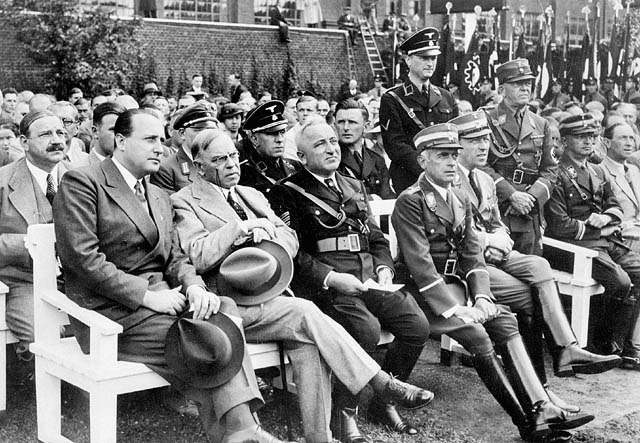Looking into the subject, I noticed that there is a scarcity of English works likening the Hebrews’ captivity in Egypt to the Jewish captivity in Axis-occupied territories. This surprised me: although there were important differences between the Exodus tale and Jewish life during WWII, the Axis’s Jewish neoslaves, of all people, surely could not have failed to see the striking parallels between their plight and that of their ancient predecessors under Egyptian rule. Some Axis employés and collaborators even deployed whips to castigate or intimidate neoslaves. That hardly any works would comment on these obvious similarities is utterly baffling.
Nevertheless, I managed to find a few. Much like the Book of Esther, the Book of Exodus served as a source of comfort and sustained the morale of many Jews stuck under Axis domination. It is worth mentioning that Jews and goyim were drawing parallels between Pharaoh (the antagonist in Exodus) and Adolf Schicklgruber as early as 1933. Quoting Gavriel D. Rosenfeld’s ‘Who Was “Hitler” Before Hitler? Historical Analogies and the Struggle to Understand Nazism, 1930–1945’, pgs. 263–265:
Jewish observers continued a longstanding tradition of typologically interpreting present-day persecutions in light of biblical precedents.⁸⁹ Jewish commentators identified a range of ancient enemies as models for Hitler. The most commonly invoked were the Egyptian pharaoh at the time of the Exodus, the Persian courtier, Haman, from the Book of Esther, and the Seleucid King, Antiochus IV. These figures were typically mentioned around the time of the holidays that chronicled their anti-Jewish deeds: Passover, Purim, and Hanukkah.
In keeping with longstanding Jewish practice, the Jews’ biblical oppressors were described as malevolent, but ultimately failed, tormentors. At the time of the [Third Reich’s] economic boycott of Jewish businesses in April 1933, for example, Jewish rabbis and writers described Hitler as a “perfect disciple” and “modern-day revival” of Pharaoh.⁹⁰
But when Passover arrived one week later, journalists issued the hopeful declaration that, whereas “Pharaoh was the first” of his kind, Hitler would “probably [be] the last,” for just as “Pharaoh and his Egypt are no more,” so, too, will “Hitler and his kind of Germany […] soon be no more. And the Jew will live on.”⁹¹
[…]
Philip M. Raskin’s 1933 poem, “A Jew to Hitler,” which included the following stanzas:
Hitler, we shall outlive you
As we outlived the Hamans before you;
Hordes of slaves may crown you chief
Throngs of fools—adore you …Hitler, we shall outlive you
However our flesh you harrow;
Our wondrous epic shall only add
The tale of Another Pharaoh.⁹⁶[…]
Christian commentators often echoed these analogies, though for different reasons. Some did so in order to show empathy for the Jews’ plight. In 1935 in Scotland, Reverend J. Peltz called Pharaoh the “first Hitler” and said that “what is taking place today in Germany and Poland is simply an experience that is duplicated in Jewish life.” He added, however, that “the pogroms of the past were as nothing compared with the cultural persecution in Germany to-day.”⁹⁷ In 1936, the African American press compared Hitler to the “Pharaoh of Moses’s time” for threatening Jews with “still harsher plagues of […] persecution.”⁹⁸
Marc Saperstein’s Agony in the Pulpit: Jewish Preaching in Response to Nazi Persecution and Mass Murder, 1933–1945 is opulent with Rabbis casting the Third Reich’s head of state as a latter-day Pharaoh. Yet paradoxically, as the years went on and the Fascists’ oppression of Jews only intensified, some Rabbis began questioning this analogy because Adolf Schicklgruber was making Pharaoh look gentle by comparison! Pages 60–1:
Pesach of 1933, coming a few weeks after the first mass protest rally in the United States, presented a fine opportunity for making connections with the past. On April 11, 1933, the first day of Pesach, Israel Levinthal of Brooklyn, New York, preached on the topic, “The Old Pharaoh in Modern Garb,” a theme that continues throughout the sermon:
Not for many years has the story we read in the Passover Haggadah, as we sit at our Seder table, had the reality for us that it has in our day. What new meaning do we find in the words, “For not one alone arose to destroy us, but in every generation some rise up against us to destroy us!”
We thought that now, at least, in this glorious twentieth century, we had passed this stage of history — that Pharaohs were a thing of the past — when, lo and behold, another Pharaoh rises before our very eyes. “In every generation it is incumbent on every Israelite to look upon himself as if he had actually gone forth from Egypt,” the Haggadah says. Alas, in this generation, it has become necessary for every Israelite in certain lands of Europe to look upon himself as if he were actually living in Egypt once again.”
On the same day across the ocean, Chief Rabbi Joseph Hertz turned to a rather unfamiliar rabbinic tradition in making the connection between “Ancient Egypt and Present-Day Germany”:
Rabbinic legend tells us that Pharaoh did not share the fate of his horsemen at the Red Sea. He alone escaped drowning; nay more, he escaped death. He stands forever at the gates of Hell; and as, in the course of the centuries, oppressor after oppressor enters, he greets them with the words, “Why have ye not profited by my example?” […]
I shall not labour the Egyptian analogy. But one need be neither Rabbi nor even religionist to see that the world is built somehow on moral foundations, and that no nation which chooses anti-Semitism, i.e., the will to hate, as the basis of its national life, can have a future.
And here is Marcus Ehrenpreis on the same day in Stockholm, Sweden: “A comparison between the memory of Egypt and the events of today inevitably obtrudes, at once disheartening and consoling. It proves that despite several thousand years of civilization, we have failed to gain any appreciable ground in terms of our humanity.”
A year later, Israel Goldstein in New York would also emphasize in his Pesach sermon the similarities between antiquity and the present: “The four-fold condition suffered by our ancestors in Egypt is duplicated in the tragic story of the Jew in Nazified Europe since 1933. Physical atrocities have been perpetrated upon thousands of Jews with a brutality reminiscent of the Egyptian Pharaoh.”
But nine years later, in the spring of 1942, Hertz would emphasize the differences: “The tidal wave of ghastly carnage passing over Russian and Polish Jewry is infinitely worse than anything that Pharaoh of old ever was guilty of. The murderers will have the same end.”
There were indeed some traditionalist preachers who delivered Pesach sermons in the ghettos without any reference to the present, as if the insistence on refusal to recognize the [Fascists] and the world they had created was a kind of internal triumph.¹⁰⁸ But for most, the connection with antiquity was too natural to ignore.
Saperstein shared so many instances of these that I cannot possibly hope to share all of them without testing your patience. To end this topic on a lighter note, though, I have a relevant selection that would be especially appealing to Palestinians. It isn’t about them specifically, but I never tire of reminding everyone that Jews are their siblings.
From Avinoam J. Patt’s ‘Ghetto in Flames: The Warsaw Ghetto Uprising in Early Postwar Jewish Literature’ in The Palgrave Handbook of Holocaust Literature and Culture, pg. 74:
Leivick’s Der Nes in Geto (The Miracle of the Ghetto) opened in October 1944 and played for 20 weeks in NYC before going on tour in early 1945. In the play, a diverse group of Jewish characters represent a cross-section of Jewish society—a Zionist, a Bundist, a Hassidic Rabbi (Reb Itzik), a fighter from the Land of Israel named Joseph, the daughter of a convert, and others—unite to become the backbone of the struggle against the [Third Reich].²²
The first act opens on Passover eve, as the remaining Jews, trapped in the ghetto, prepare for the holiday while waiting for the arrival of weapons. The first scene is set in a basement synagogue, where two young Jews, Yudel and Leibush, stand, immersed in prayer, as if in a dream. The stage directions indicate that above the Holy Ark a large banner proclaims: “Gevald Yidn, Zayt Zikh Nisht Meya’esh!” [Woe Jews, Do Not Despair!]²³
One character named Isaac compares their imprisonment to slavery in Egypt: “Why is this night different from all other nights? On all other nights we let ourselves be led like calves into the gas chambers. But on this Passover night we will not let that happen. We will shoot. With what will we shoot, ha? With what? Now this is a kashya [a question].”²⁴
The play charts the transformation of Jews traditionally unprepared for combat, into a realization that the only path is armed struggle. Israel, initially passive, eventually embraces armed resistance after his girlfriend Rachel dies on an underground mission to obtain arms, after the Polish Underground fails to deliver them.
In the third act, Israel returns to the ghetto with dynamite, which he uses to blow up [an Axis] tank, declaring to the other Jewish fighters, “I know that even in your fear you are wonder Jews […] And I know now, that with one grenade it is possible to destroy a whole tank…” (Leivick, 318).
Before exploding himself along with the tank, Israel proclaims to those assembled around him, “The wicked one may be stronger than us, but not his wickedness. Tanks will continue to come — let them come. We will confront them. For what do we need dynamite? With our hearts will we destroy the tanks. A Jew is stronger than tanks.”²⁵
(Emphasis added in all cases.)
One last bit of trivia: when I first heard the famous motto ‘let my people go’ (from Sam & Max Save the World, of all things), I correctly associated it with Jewish culture but mistakenly assumed that it only dated back to WWII. It actually comes from Exodus, but anybody familiar with Victor Gollancz’s 1942 pamphlet would have forgiven me for having that mistaken assumption!
I wish you all a very pleasant Pesach.












